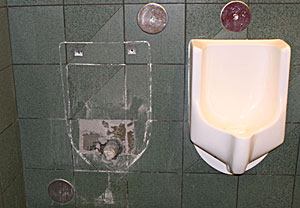 |
|
Lisa Rich/Arizona Daily Wildcat
|
Chipped cement and a small hole in the wall are all that is left after a broken urinal was removed from the men's restroom in the Manuel T. Pacheco Integrated Learning Center.
|
|
|
By Laura Ory
Arizona Daily Wildcat
Wednesday, October 12, 2005
Print this
Students can expect more tuition hikes if the state Legislature doesn't fund a large portion of the $58 million needed for building repairs next year.
The Arizona Board of Regents approved the UA's request last week for $38 million for building renewal from the 2007 fiscal year state-operating budget.
But if the UA doesn't receive these funds, the university will be forced to take out 15- to 20-year bonds, said Greg Fahey, assistant vice president of UA Government Relations.
The interest from these bonds would amount to about $13.3 million, which would be funded by tuition increases, according to the budget request.
The Legislature has not allocated any funds for the state universities' building renewal costs since 2001, and the lack of funds have added up, costing the UA more than $176 million since 1995, according to the budget request.
This year, the university has already taken out a $10 million bond for building maintenance and repairs, Fahey said.
"It's like buying an air conditioner and paying for it for the next 20 years. It's not the best use of taxpayers' money," said Ted Gates, regent assistant executive director for capital resources.
Fahey credits the Legislature's lack of funding to state budget cuts in 2001, causing the Legislature to cut building renewal funds on a one-time basis that has extended for five years.
The fact that building renewal isn't a glamorous cause for funds may also be a factor, Fahey said.
President Peter Likins said by not funding the requests, the state is failing to meet standards they set forth in a statute specifically geared toward university maintenance.
Arizona has a statute that requires the Legislature to pay for building maintenance costs each year, which are calculated by a formula that takes the age, replacement value and life expectancy into consideration, Likins said.
"The sad reality is that the Legislature has been ignoring its own statute," Likins said.
The lack of funds can be seen in classrooms at the UA, because while some have been supplied with new technologies, others remain outdated, Likins said.
Robin Polt, a UA chemistry professor, said he was forced to move his lab from the Old Chemistry building last year because it was lacking needed maintenance and repairs.
The reason for the move was electrical problems within the lab, where the temperature inside fluctuated between 50 degrees at night and 90 degrees during the day, Polt said.
The temperature extremes were problematic because temperature-sensitive ether was used in his research to create a morphinelike pain reliever without the serious side effects, Polt said.
"It wasn't safe, and it was miserable to work in there," Polt said.
The condition of the lab also made it hard to attract graduate students looking for research opportunities in that field.
"Who wants to work in a 1950s-style lab when you could be in a brand-new facility?" Polt said.
Polt said he requested for the lab to be repaired but he was asked to move instead. The lab is now in the Henry Koffler building, but the move delayed progress in the research and some equipment was broken during the move, he said.
Joel Valdez, senior vice president for business affairs, said maintenance and repairs of research facilities receive top priority over other campus facilities because of their importance to the university's revenue.
Valdez said the types of maintenance and repairs that campus buildings require ranges from safety issues like leaking roofs to handicap accessibility and replacing equipment like air conditioning units.
"When the money isn't there to fix these problems, buildings deteriorate," Valdez said. "It's no different from your own home."
In the past, about one-third of the university's buildings were inspected each year to determine maintenance needs, but because of the lack of funding, there isn't enough staff to complete the inspections, Valdez said.
Instead, a computer program will be used to calculate the expected costs of building renewal starting this year, he said.
